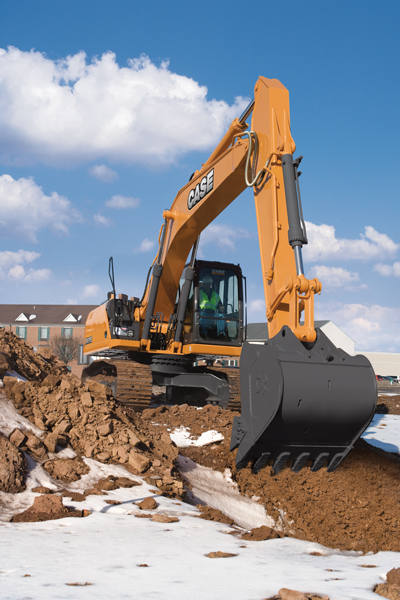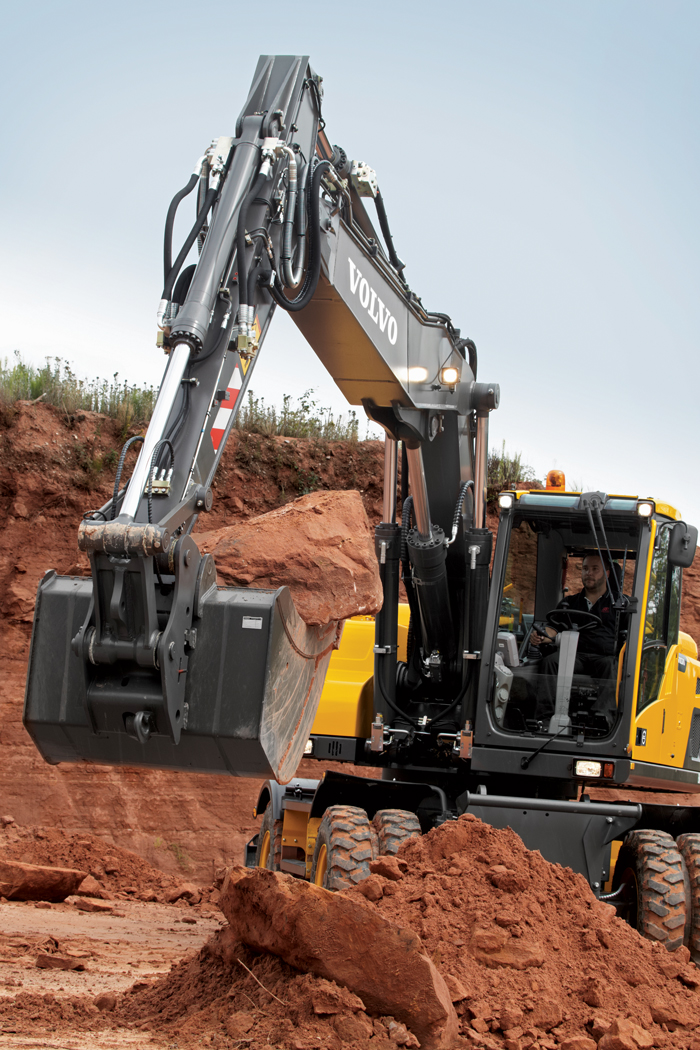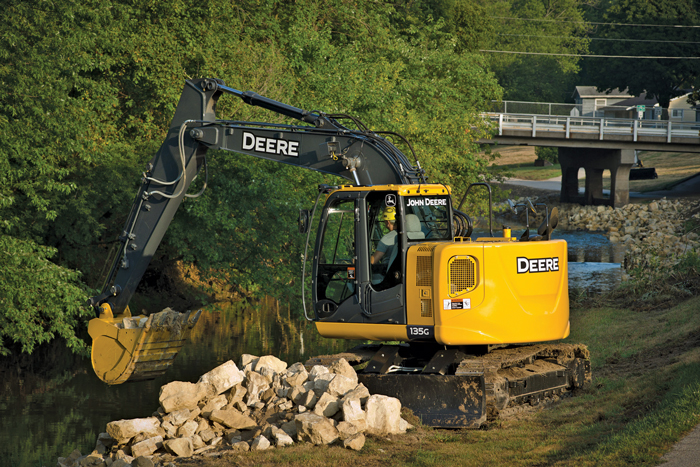Excavators 101
 The first hydraulic excavator in America was built before 1900, but it was another half century before the machine was wheel-mounted and popularized. When tractor-mounted backhoes and then purpose-built excavators did arrive, utility contractors surely exulted. Digging trenches for water lines and undertaking other municipal projects suddenly wasn’t backbreaking work.
The first hydraulic excavator in America was built before 1900, but it was another half century before the machine was wheel-mounted and popularized. When tractor-mounted backhoes and then purpose-built excavators did arrive, utility contractors surely exulted. Digging trenches for water lines and undertaking other municipal projects suddenly wasn’t backbreaking work.
Today, the hydraulic excavator, along with skid steer loaders, is an indispensable part of any contractor’s equipment yard. Digging and trenching, moving and laying pipe or cable, the modern excavator does it all.
Versatile Machine
“It has become the Swiss army knife of the jobsite,” is how John Waldron puts it. Adds the Production Manager for Volvo Construction Equipment: “There are more excavators sold than most other machines, except compact machines like skid steer loaders, because they can handle attachments like a mower, drill, hammer or multiprocessor, and be used in demolition and other segments and applications. It is a very versatile machine.”
The machine hasn’t changed dramatically in recent decades, except in terms of fuel efficiency, mandated emission controls and safety of operation. But major producers of hydraulic excavators keep competitively refining the machines to make them more productive.
For example, several manufacturers of mid-size excavators have tried to replicate the zero tail swing radius of mini excavators. The longer reach of larger excavators requires counterbalancing tails that usually poke out, but trenching or removing soil from a tight jobsite is hampered by the tails. Consequently, minimal tail protrusion is popular with utility contractors, and manufacturers have responded.
“The Caterpillar 320ERR is a machine that has been designed specifically for the utility contractor,” says John Crowley, Marketing Consultant for Caterpillar. “The machine has a heavier counterweight and a shorter tail swing radius that enables the machine to work in a single lane enclosure.”
Not all manufacturers make excavators tailored to utility work, but minimal tail swing is a common feature. For example, the John Deere 135G and 245G excavators appeal to contractors because the machine’s tails project just 4 in. beyond the track. “The operator can concentrate on the working end of the excavator instead of thinking about the back of the machine,” says Michael Boyle, Product Consultant Manager for John Deere Construction and Forestry. “Money is made on the front end where the bucket is located.”
 Blades and Tires
Blades and Tires
The Deere 135G is adapted to utility situations with the addition of a backfill blade. Besides backfilling, the lowered blade in front gives the machine extra stability. Furthermore, Boyle notes that when the tracks are positioned on a working excavator so the lowered blade is behind the operator, the machine can dig 8 in. deeper.
The JD excavator also can be converted to rubber tracks for operating on paved surfaces. Volvo offers track conversions, too, but it also has models that are even more pavement-friendly: Volvo EW 160D and EW 180D excavators roll on rubber tires instead of steel tracks.
This not only makes working from paved streets and parking lots more feasible, it means that moving the machinery among adjacent sites can be accomplished under their own power. The smaller Volvo units also can be transported on a trailer with a permit, which is an important consideration for a small utility contractor.
George Lumpkins, Product Marketing Manager for Kobelco Construction Machinery USA, says real value comes from having properly sized machines. “Our 15- to 17-ton machines were specifically designed for the North American market. This is an uncommon size in the rest of the world.” Not only can Kobelco excavators of that size be hauled without permits, Lumpkins points out that “the 17-ton weight is the maximum that can be pulled behind a dump truck.”
It’s already been noted that attaching different tools to the end of an excavator’s boom enhances its value. While the range of attachments is impressive, two are particularly in demand.
 “The most popular attachments for the utility market are thumbs and hammers or breakers,” says Brad Stemper, Solutions Marketing Manager for Case Construction Equipment. “Thumbs give an excavator extra grabbing capabilities, and are particularly helpful when handling pipe and other items on site. Hammers are especially helpful in regions where hard rock may be encountered in the excavation process.”
“The most popular attachments for the utility market are thumbs and hammers or breakers,” says Brad Stemper, Solutions Marketing Manager for Case Construction Equipment. “Thumbs give an excavator extra grabbing capabilities, and are particularly helpful when handling pipe and other items on site. Hammers are especially helpful in regions where hard rock may be encountered in the excavation process.”
The advent of quick couplers contributed dramatically to the use of attachments. Switching from one attachment to the other on the go was a big evolutionary step in the excavator’s emergence as a tool of choice. “Quick couplers and thumbs drastically improved the efficiency of the machines,” says Lumpkins.
Bucket Size
What does not always contribute to the performance of a hydraulic excavator is an oversized bucket.
“I think that contractors believe that large excavator buckets increase productivity. In reality, an excavator with an extra-large bucket is like hanging a boat anchor on the machine,” says Boyle. “An excavator senses a heavy bucket and backs off the pumps to build torque, which slows the cycle time and lowers productivity. An excavator with a properly sized bucket will be quicker, more fuel efficient and easier to operate, resulting in more productivity.”
Crowley agrees that sizing buckets correctly is important. “Caterpillar provides approved bucket and hydro-mechanical work tool matching charts in our brochures to correctly match the machine. If the excavator carries a bucket above and beyond the recommended approved size, machine durability may be affected as well as stability.”
Lumpkins says one consequence of the oversizing of buckets is that manufacturers for the U.S. market now offer heavy-duty booms as standard. “This is due to bucket sizes that, many times, are outside of recommended guidelines.”
Heavier or not, the booms on hydraulic excavators still get broken. Waldron attributes it to operator abuse. “Probably the biggest misuse of excavators is that operators tend to sweep with them — use booms for brooms — and end up breaking booms and arms,” he says. “A boom is made to pull things to you, not sweep sideways. We keep making them heavier and stronger to prevent breakage.”
Maintenance Priority
Yet manufacturers agree that the most chronic error made by operators and owners is habitually poor maintenance (see sidebar).
“Neglecting regularly scheduled maintenance continues to be one of the biggest mistakes made,” says Stemper. “This includes everything from keeping grease points properly greased to oil and filter changes.” He says the latest generations of excavators are engineered to lengthen periods between maintenance in hopes the equipment will get serviced in time.
While contractors do want longer service intervals, Boyle says, they also want their operators to follow maintenance schedules. He recommends that John Deere excavator owners use a detailed and color-coded Deere maintenance chart to stay on top of maintaining their machines.
The more sophisticated Tier 4 Interim and Final engines certainly require regular service; the trade-off of taking care of the engines is increased horsepower and fuel economy. That adds to their versatility.
“As work gets more demanding, the more you can get out of a single machine the better,” Boyle says. “Horsepower ranges have increased over the years and fuel use has been reduced, making the machines more efficient. Having the flexibility to stretch what a machine can complete without moving up a size class in weight range helps provide more dollars to the bottom line of any company.”
Giles Lambertson is a Freelance Writer for Utility Contractor, based in Winchester, Kan.
Time for TLC
Even Hard-Working Excavators Need Some Regular Upkeep
To maintain an excavator in prime condition so it doesn’t quit operating with a sewer line only half-dug, manufacturers offer several incentives. They do so to remind machinery owners that sweet-running machines need more than loving pats on their hoods to keep performing at high levels of efficiency.
The first maintenance incentive is easy access for checking vital fluids and breathing systems. This falls in the category of preventive maintenance. After all, we are talking about hydraulic excavators — hydraulic fluid being key to so many essential functions. To encourage regular checking, large service doors are the rule so that dipsticks and fill points are easily accessed. When fluid changes are required, drains typically are handy so that spillage risk is lessened.
Spin-on filters in easy-to-reach places are common for engine and hydraulic systems, because maintaining fluid levels is only part of the battle in dirty construction environments. Unclean fluids can damage equipment and cause it to underperform, and fluids that have lost their viscosity simply are not providing the oomph they should provide.
A second level of maintenance incentives is the dealership service program. Dealers don’t want machines to fail either: Future sales may hinge on it. So dealers have comprehensive maintenance programs that try to anticipate when parts will wear out and systems will need tuning up. For example, in the Volvo Care Track program, owners and dealers can methodically check machine components and systems.
While maintenance techs for a contractor can and often do regularly perform some of these functions, the finer points of maintenance are best left to a dealership technician. He is the brand expert and usually works in a shop better equipped to undertake major service or repair operations.
The final incentive for owners and operators is the electronic reminder that the time has arrived to service an excavator. Programmed signals about service are integrated into excavators at the factory — an indication of the importance of maintenance.
Then there are telematics, the GPS tracking mechanisms that monitor systems in a machine, sending readouts to a central office. This is especially important to larger utility contractors who operate a fleet of machines. From a single vantage point, an owner or fleet manager can see when a machine is scheduled for periodic servicing or has a failing system. Case Construction calls its telematics system Case Fleet Connect, but whatever the name, equipment maintenance is the aim.




